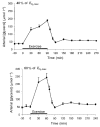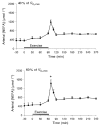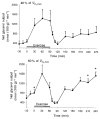Post-exercise adipose tissue and skeletal muscle lipid metabolism in humans: the effects of exercise intensity
- PMID: 10790168
- PMCID: PMC2269892
- DOI: 10.1111/j.1469-7793.2000.00919.x
Post-exercise adipose tissue and skeletal muscle lipid metabolism in humans: the effects of exercise intensity
Abstract
One purpose of the present experiments was to examine whether the relative workload or the absolute work performed is the major determinant of the lipid mobilization from adipose tissue during exercise. A second purpose was to determine the co-ordination of skeletal muscle and adipose tissue lipid metabolism during a 3 h post-exercise period. Six subjects were studied twice. In one experiment, they exercised for 90 min at 40% of maximal O2 consumption (VO2,max) and in the other experiment they exercised at 60% VO2,max for 60 min. For both experiments, catheters were inserted in an artery, a subcutaneous abdominal vein and a femoral vein. Adipose tissue metabolism and skeletal muscle (leg) metabolism were measured using Fick's principle. The results show that the lipolytic rate in adipose tissue during exercise was the same in each experiment. Post-exercise, there was a very fast decrease in lipolysis, but it began to increase about 1 h post-exercise and remained elevated for the following 2 h. The increase in post-exercise non-esterified fatty acid (NEFA) mobilization was greater after 60% exercise than after 40 % exercise. It is concluded that the lipolytic rate in abdominal subcutaneous adipose tissue during exercise is the same whether the relative workload is 40% or 60% of maximum. Post-exercise, there is a substantial lipid mobilization from adipose tissue and only a small fraction of this is taken up in the lower extremities. This leaves a substantial amount of NEFAs for either NEFA/TAG (triacylglycerol) recirculation post-exercise or immediate oxidation.
Figures






Similar articles
-
Role of the sympathoadrenergic system in adipose tissue metabolism during exercise in humans.J Physiol. 2001 Oct 1;536(Pt 1):283-94. doi: 10.1111/j.1469-7793.2001.00283.x. J Physiol. 2001. PMID: 11579176 Free PMC article.
-
Postprandial triacylglycerol uptake in the legs is increased during exercise and post-exercise recovery.J Physiol. 2005 Nov 1;568(Pt 3):941-50. doi: 10.1113/jphysiol.2005.091975. Epub 2005 Jul 14. J Physiol. 2005. PMID: 16020461 Free PMC article. Clinical Trial.
-
Human skeletal muscle fatty acid and glycerol metabolism during rest, exercise and recovery.J Physiol. 2002 Sep 15;543(Pt 3):1047-58. doi: 10.1113/jphysiol.2002.023796. J Physiol. 2002. PMID: 12231658 Free PMC article.
-
The Physiological Regulation of Skeletal Muscle Fatty Acid Supply and Oxidation During Moderate-Intensity Exercise.Sports Med. 2015 Nov;45 Suppl 1(Suppl 1):S23-32. doi: 10.1007/s40279-015-0394-8. Sports Med. 2015. PMID: 26553490 Free PMC article. Review.
-
Fat as a fuel: emerging understanding of the adipose tissue-skeletal muscle axis.Acta Physiol (Oxf). 2010 Aug;199(4):509-18. doi: 10.1111/j.1748-1716.2010.02128.x. Epub 2010 Mar 26. Acta Physiol (Oxf). 2010. PMID: 20353493 Review.
Cited by
-
Adipose Tissue Macrophage Polarization Is Altered during Recovery after Exercise: A Large-Scale Flow Cytometric Study.Curr Issues Mol Biol. 2024 Feb 2;46(2):1308-1317. doi: 10.3390/cimb46020083. Curr Issues Mol Biol. 2024. PMID: 38392201 Free PMC article.
-
Interleukin-6 production in human subcutaneous abdominal adipose tissue: the effect of exercise.J Physiol. 2002 Aug 15;543(Pt 1):373-8. doi: 10.1113/jphysiol.2002.019380. J Physiol. 2002. PMID: 12181307 Free PMC article.
-
Both moderate- and high-intensity exercise training increase intramyocellular lipid droplet abundance and modify myocellular distribution in adults with obesity.Am J Physiol Endocrinol Metab. 2023 Nov 1;325(5):E466-E479. doi: 10.1152/ajpendo.00093.2023. Epub 2023 Sep 20. Am J Physiol Endocrinol Metab. 2023. PMID: 37729021 Free PMC article.
-
Autonomic nervous activity and lipid oxidation postexercise with capsaicin in the humans.J Sports Sci Med. 2010 Jun 1;9(2):253-61. eCollection 2010. J Sports Sci Med. 2010. PMID: 24149693 Free PMC article.
-
Metabolic effects of interleukin-6 in human splanchnic and adipose tissue.J Physiol. 2002 Aug 15;543(Pt 1):379-86. doi: 10.1113/jphysiol.2002.021022. J Physiol. 2002. PMID: 12181308 Free PMC article. Clinical Trial.
References
-
- Arner P, Liljeqvist L, Ostman J. Metabolism of mono-and diacylglycerols in subcutaneous adipose tissue of obese and normal-weight subjects. Acta Medica Scandinavica. 1976;200:187–194. - PubMed
-
- Bahr R. Excess postexercise oxygen consumption – magnitude, mechanisms and practical implications. Acta Physiologica Scandinavica Supplementum. 1992;605:1–70. - PubMed
-
- Bahr R, Hansson P, Sejersted OM. Triglyceride/fatty acid cycling is increased after exercise. Metabolism. 1990;39:993–999. - PubMed
-
- Bergman BC, Butterfield GE, Wolfel EE, Casazza GA, Lopaschuk GD, Brooks GA. Evaluation of exercise and training on muscle lipid metabolism. American Journal of Physiology. 1999;276:E106–117. - PubMed
-
- Bülow J. Subcutaneous adipose tissue blood flow and triacylglycerol-mobilization during prolonged exercise in dogs. Pflügers Archiv. 1982;392:230–234. - PubMed
Publication types
MeSH terms
Substances
LinkOut - more resources
Full Text Sources

